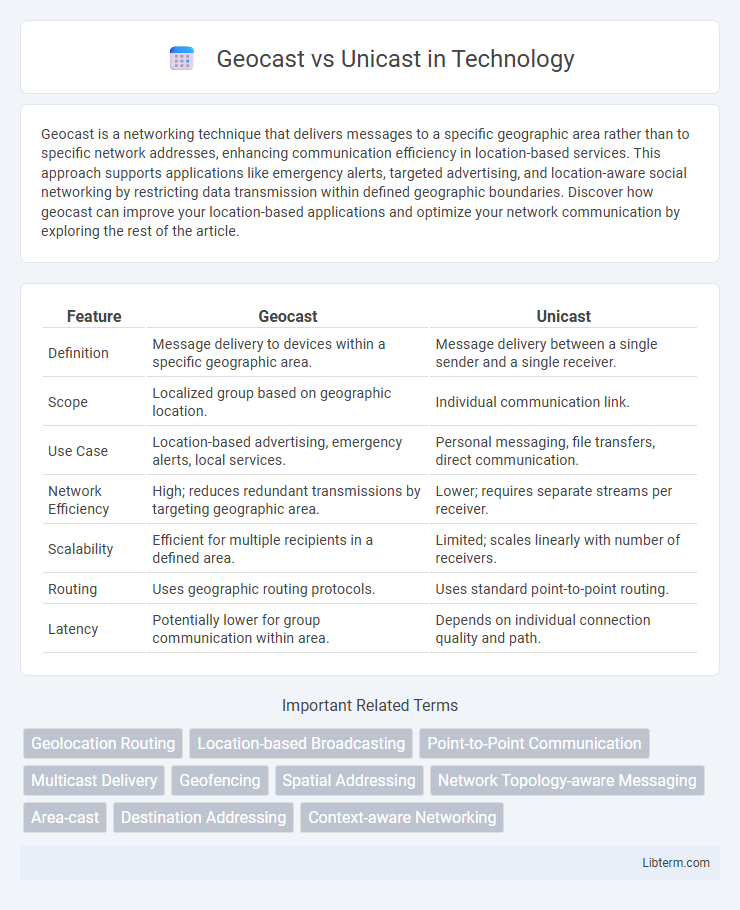Geocast is a networking technique that delivers messages to a specific geographic area rather than to specific network addresses, enhancing communication efficiency in location-based services. This approach supports applications like emergency alerts, targeted advertising, and location-aware social networking by restricting data transmission within defined geographic boundaries. Discover how geocast can improve your location-based applications and optimize your network communication by exploring the rest of the article.
Table of Comparison
| Feature | Geocast | Unicast |
|---|---|---|
| Definition | Message delivery to devices within a specific geographic area. | Message delivery between a single sender and a single receiver. |
| Scope | Localized group based on geographic location. | Individual communication link. |
| Use Case | Location-based advertising, emergency alerts, local services. | Personal messaging, file transfers, direct communication. |
| Network Efficiency | High; reduces redundant transmissions by targeting geographic area. | Lower; requires separate streams per receiver. |
| Scalability | Efficient for multiple recipients in a defined area. | Limited; scales linearly with number of receivers. |
| Routing | Uses geographic routing protocols. | Uses standard point-to-point routing. |
| Latency | Potentially lower for group communication within area. | Depends on individual connection quality and path. |
Introduction to Geocast and Unicast
Geocast routing delivers messages to all devices within a specific geographic area, enabling location-based communications ideal for applications like emergency alerts and location-aware services. Unicast routing sends data packets from a single sender to a single receiver using a unique IP address, ensuring direct and precise communication between two endpoints. Unlike unicast, geocast optimizes network resources by targeting only relevant geographic nodes rather than individual addresses.
Definition of Geocast
Geocast is a network communication method that delivers messages to devices within a specific geographic area, enabling location-based data transmission. Unlike unicast, which sends data from one sender to a single receiver, geocast targets multiple nodes confined to a defined spatial region. This technique is essential in applications like vehicular networks, emergency services, and location-aware advertising.
Definition of Unicast
Unicast refers to a one-to-one communication method where data is sent from a single sender to a single receiver over a network, ensuring a dedicated and direct transmission path. This transmission type contrasts with Geocast, which targets multiple receivers within a specific geographic area. Unicast is the foundation of most internet-based communication, providing reliable, point-to-point data exchange.
Core Differences Between Geocast and Unicast
Geocast targets data transmission to a specific geographic region, efficiently delivering information only to devices within a defined area, unlike Unicast, which sends data from one sender to one specific receiver, regardless of location. Geocast optimizes network bandwidth by limiting message distribution, while Unicast requires separate transmissions for each recipient, potentially increasing bandwidth usage. Core differences include the multicast scope in Geocast based on geographical zones versus the point-to-point connection model of Unicast communication.
Use Cases for Geocast
Geocast excels in location-based services such as emergency alerts, targeted advertising, and real-time traffic updates by delivering messages to devices within a specific geographic area. Unlike unicast, which sends data to a single recipient, geocast improves network efficiency by broadcasting information to multiple users in a defined location, reducing bandwidth usage. Applications in disaster management, smart city infrastructure, and location-aware social networking leverage geocast to provide timely, context-relevant communication.
Use Cases for Unicast
Unicast communication is ideal for one-to-one data transmission scenarios such as video conferencing, file transfers, and personalized content delivery where a specific device or user requires targeted data. This method ensures direct communication between the sender and a single recipient, minimizing network traffic and enhancing security through precise data routing. Use cases include streaming services like Netflix, remote desktop access, and secure financial transactions that demand reliable and exclusive data exchange.
Advantages of Geocast
Geocast enables efficient data transmission by targeting a specific geographic area, reducing network congestion and lowering bandwidth usage compared to Unicast, which sends separate transmissions to each recipient. This method enhances scalability in wireless sensor networks and location-based services by minimizing redundant data packets. Geocast's ability to deliver context-aware information boosts performance in applications such as emergency response and mobile advertising.
Advantages of Unicast
Unicast provides a dedicated communication channel between a single sender and receiver, ensuring efficient and reliable data transmission with minimal interference. It supports direct acknowledgment and error recovery, enhancing the accuracy and integrity of the transmitted data. Unicast's ability to tailor content for individual recipients optimizes bandwidth usage by avoiding unnecessary data distribution.
Challenges and Limitations
Geocast faces challenges in accurately defining and maintaining dynamic geographic regions, leading to potential message delivery overlaps or misses. Unicast struggles with scalability issues as the number of individual recipients increases, causing higher network load and latency. Both methods encounter limitations in ensuring efficient resource usage and reliable transmission across diverse network conditions.
Future Trends in Geocast and Unicast Networking
Future trends in Geocast networking emphasize scalable, location-based multicast communication optimized for smart cities and IoT applications, enhancing efficient data dissemination to targeted geographic regions. Unicast networking continues to evolve with advanced machine learning algorithms for personalized content delivery and improved bandwidth management in 5G and beyond networks. Both approaches integrate edge computing and network slicing to support real-time, context-aware services and ultra-low latency requirements in next-generation communication systems.
Geocast Infographic

 libterm.com
libterm.com